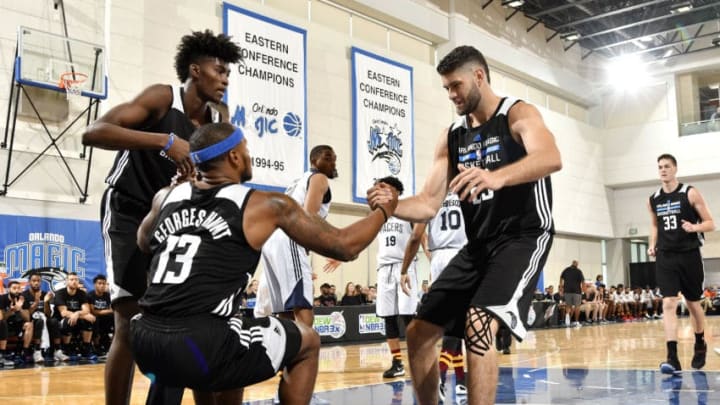The Orlando Magic are turning a corner, as the team is crafting their roster to compete in the positionless NBA, rather than trying to fight the trend like.
The style of basketball the Golden State Warriors play has revolutionized the NBA. The Warriors’ “death lineup,” a lineup made with mostly long and athletic players with no defined big man, has become possibly the most lethal lineup in the NBA. It forces opposing teams to bench their slower big men to match up with the Warriors’ size and shooting.
Because of the Warriors recent domination of the league, teams are striving to emulate their model of near positionless basketball. All around the league teams are changing their long-term game plans to fit this new style.
The Boston Celtics are the most notable example of this. Coach Brad Stevens is now emphasizing the three position game (guard, forward, big man) and the team is stocking up on versatile and athletic forwards.
Last offseason, the Orlando Magic tried to go against the grain and follow the Memphis Grizzlies‘ oversized model of basketball. The Magic decided to try to go big and stock up on centers and power forwards.
They went out and traded Victor Oladipo and their lottery pick (Domantas Sabonis) for Serge Ibaka. The Magic also signed former Toronto Raptors center Bismack Biyombo.
This approach from former general manager Rob Hennigan was an unmitigated disaster. The oversized Magic struggled mightily on offense and could not defend smaller, faster teams.
New president of basketball operations Jeff Weltman has made it a point to differ from Hennigan’s strategy. The Magic have started to embrace the new NBA.
Orlando’s new executives are known for drafting long, versatile players such as Giannis Antetokounmpo, Thon Maker and Bruno Caboclo. They have brought this approach to the Magic, even in a short time.
Orlando has modernized its roster, even in just one summer. It is a preview of what might come next as the Magic continue to build.
The team has done this through every stage of the offseason.
First, the Magic’s draft is perfect for today’s NBA. It meets the style the Magic want to adopt.
Orlando went after the most versatile player in the NBA draft, disregarding supposed positional needs. Jonathan Isaac is 6-foot-11 with a 7-foot wingspan. He is the type of player who can play inside and out on offense and guard anybody on the court.
The Magic’s second round pick was Wesley Iwundu, a 6-foot-7 player with a 7-foot-1 wingspan. Both Wesley Iwundu and Jonathan Isaac have great versatility. It shows the direction the Magic want to go, able to go positionless at times and switch on the perimeter defensively.
While the Magic will be nowhere near the Warriors anytime soon, this is the strategy rebuilding teams must take to be able to compete in the future. They should focus on players who can play multiple positions and have varied skill sets, making it easier to put the team’s five best players on the floor.
Isaac’s possibilities seem endless with talk of him playing either forward spot and potentially even center in smaller lineups.
The Magic’s free agent signings and rumored targets also showed the Magic were trying to emulate the Warriors model and go smaller and more versatile.
The Magic were reportedly interested in Utah Jazz forward Joe Ingles. While Ingles is not very athletic, he is a top-notch point forward who can do a little bit of everything on offense. The Warriors have this in Draymond Green, who is a crucial part of their small-ball lineup.
The Magic fell short in signing him — he opted to stay with the Jazz — but it was a sign of the kind of player they were chasing.
Orlando’s actual signings further proved this point.
While the Shelvin Mack signing has little to do with positionless basketball, the Jonathon Simmons signing clearly shows the team’s direction.
Jonathon Simmons is a versatile forward, making a name for himself by guarding multiple positions with great skill and intensity. Simmons posted a solid 2.1 defensive win shares, which is especially solid given he only played 17.8 minutes per game.
Further, recent signings in Arron Afflalo and Marreese Speights are reasonably versatile players with strong shots. They are not reputed as strong defenders, but they can both stretch the floor and give space to the team’s other versatile weapons.

Orlando Magic
Like the Celtics, the Magic are loading up on athletic forwards that can guard multiple positions on defense.
Further, Hennigan left the team with pieces that fit this style of play.
The most obvious player is Aaron Gordon. While he is listed as a power forward, he can guard every player on the court from the opponents quick guards to their big men.
Another example is third-year player Mario Hezonja. While he is certainly not a key part of the Magic’s core, Mario Hezonja fits positionless basketball better than anyone on the team. Drafted as a shooting guard, Hezonja has played brief minutes at the 1, 2, 3 and 4. While not great at any role, Hezonja clearly has the ability to play practically anywhere on the court.
But the Magic are still far away from completing a team ready to compete in a positionless basketball NBA. The Magic have interior/offensive oriented center Nikola Vucevic and undersized point guard D.J. Augustin. Both have little to no versatility and place in the new NBA.
There is still work for Jeff Weltman to do to push this team into the 21st century.
Next: Orlando Magic's expectations, goals become clear
The Magic are crafting their team based on the positionless basketball principles, creating a long athletic team that could one day compete with the Warriors. After this summer, they are well on their way to getting there.
